God's Wife of Amun › Jezebel: Princess of Sidon, Queen of Israel » Origins and History
Articles and Definitions › Contents
- God's Wife of Amun › Ancient History
- Jezebel: Princess of Sidon, Queen of Israel › Who Was
Ancient civilizations › Historical places, and their characters
God's Wife of Amun › Ancient History
Definition and Origins
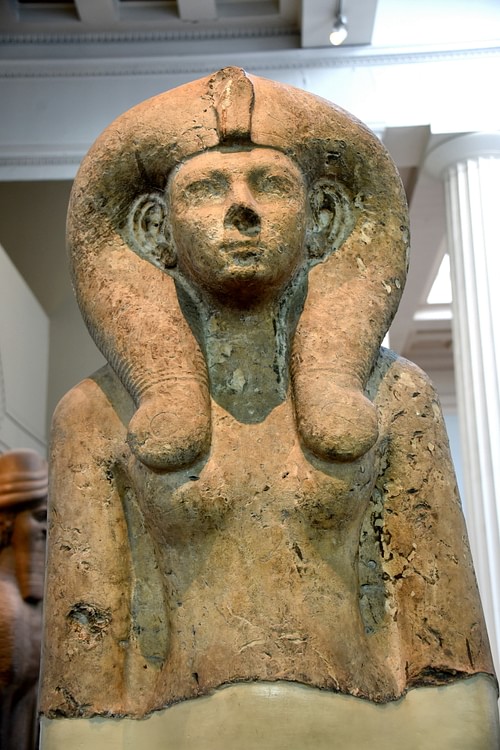
The position of God's Wife of Amun was one of the most politically powerful and spiritually significant in later Egyptian history.Elevated from a figurehead in the New Kingdom (c.1570-1069 BCE), the God's Wife of Amun would hold power equal to a pharaoh by the Third Intermediate Period of Egypt (c. 1069-525 BCE) when the God's Wife would rule Upper Egypt.
Although some scholars maintain that the position existed in the Middle Kingdom of Egypt (2040-1782 BCE), only the title is mentioned in that period and it was nothing exceptional. There were many 'God's Wives' and probably had been earlier. There was a God's Wife of Ra, a God's Wife of Ptah, and a God's Wife of Amun along with other deities' ritual wives.
These women were either the mother, wife, or eldest daughter of the king and would perform necessary rituals at ceremonies and festivals. From the beginning of the New Kingdom, however, this title would be imbued with greater power and significance. Inscriptions from the 18th Dynasty, such as the famous Donation Stele, attest to the great wealth and prestige of the God's Wives and later inscriptions make clear that the position only grew in power.
In the 20th Dynasty, Isis (also known as Iset and Aset), the virgin daughter of Ramesses VI (1145-1137 BCE) became God's Wife of Amun and, from then on, the position would be held by celibate women of royal birth, no longer wives or mothers of the king, by royal decree. Ramesses VI may have believed succession would go more smoothly if God's Wives were free to adopt a successor without considering familial obligations.
AHHOTEP I & AHMOSE-NEFERTARI
During the Second Intermediate Period of Egypt (c. 1782 - c. 1570 BCE), which followed the Middle Kingdom, Egypt was divided with no strong central government. The foreign Hyksos ruled in Lower Egypt, the Egyptians held Upper Egypt from Thebes, and the Nubians had the southern regions. The Theban prince Ahmose I (c.1570-1544 BCE) drove the Hyksos from Egypt, defeated the Nubians, and unified Egypt under his rule.
Ahmose I credited the god Amun with his victories but, significantly, also honored his mother Queen Ahhotep I (c. 1570-1530 BCE) who held the title of God's Wife of Amun (as inscribed on her sarcophagus). When Ahmose I led the army south to campaign against the Nubians, Hyksos sympathizers seem to have tried to overthrow his new administration and this rebellion was put down by Queen Ahhotep I.
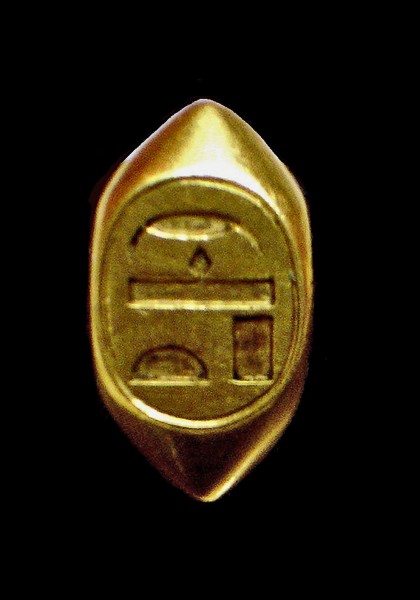
Ring of Ahhotep
Egyptologist Betsy M. Bryan observes how "Ahhotep apparently commanded the respect of local troops and grandees to preserve a fledgling dynastic line and she continued to function as king's mother well into the reign of Amenhotep I" (Shaw, 218). At some point she surrendered the role of God's Wife to her daughter, Ahmose-Nefertari, who was also Ahmose I's wife.
Prior to Ahhotep I, only two women are attested to as God's Wives of Amun: Sit-ir-bau and Ta-khered-qa, both of the late 17th Dynasty. Neither of these women is mentioned as wielding any considerable power, and the title may have been awarded posthumously. The God's Wife of Amun at that time would have played a role in certain rituals, and however important that role may have been, its influence began and ended with the ceremony.
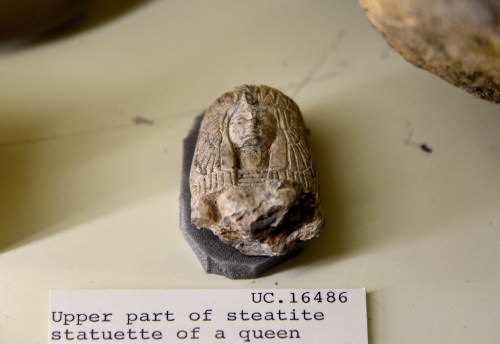
Statuette of Queen AHMOSE-NEFERTARI
THE NEW ROLE OF GOD'S WIFE
When Ahhotep I conferred the title on Ahmose-Nefertari, Ahmose I increased the power of the God's Wife dramatically and, perhaps, in a deliberate effort to diminish the power of the priests. The God's Wife was no longer a mere figurehead nor was she any kind of understudy for the king in times of crisis; now the God's Wife of Amun was effectively the female counterpart of the high priest. She was granted her own private income in compensation for performing rituals previously reserved for the high priesthood. Bryan identifies the duties of the position starting with Ahmose-Nefertari:
1. Participation in the procession of priests for the daily liturgies of Amun. She was shown accompanying the priests called "god's fathers," a general designation that could include the top four priests of the temple, known by numbered position, ie, "first priest," etc.2. Bathing in the sacred lake with the pure priests before carrying out rituals.3. Entering the most exclusive parts of the temple together with the high priest. This included the holy of holies.4. With the high priest, "calling the god to his meal," reciting a menu of food offering being presented to Amun.5. With the high priest, burning wax effigies of the enemies of the god to maintain the divine order.6. Shaking the sistrum before the god to propitiate him.7. Theoretically, as the "god's hand," assisting the deity in his self-creative masturbation. In this way and in her sistrum activity (a sexual allusion) she performed as the god's wife. (Bryan, 2)
These responsibilities and honors were rewarded with tax-exempt land, housing, food, clothing, gold, silver, and copper, male and female servants, wigs, ointment, cosmetics, livestock, and oil. While most of this payment was used in the performance of her duties, the lands would generate further revenue which would go directly to the God's Wife as her personal property, not to the temple.
GOD'S WIVES AFTER AHMOSE-NEFERTARI
The God's Wives who came after the reign of Ahmose I all held this same power and prestige to greater or lesser degrees.Although some of these women were the daughters of high priests, the majority were related to the king. In addition to the God's Wife, there were the honorary titles of Divine Adoratrice and God's Hand. These two lesser positions could be held by non-royal women, though usually they seem to have been filled with younger sisters or relatives of the God's Wife.
THE GOD'S WIFE OF AMUN WAS EFFECTIVELY THE FEMALE COUNTERPART OF THE HIGH PRIEST.
The responsibilities of the position of God's Hand are unclear as it is obvious that the God's Wife performed the function of God's Hand in the ritual act of creative masturbation. The Divine Adoratrice was a high priestess who assisted the God's Wife and presided over festivals and ceremonies. She seems to have held equal power to the highest priests of the temple and a Divine Adoratrice is known to have become a God's Wife a number of times.
For the most part, the dates of the women's lives below are unknown. The dates given are those of their fathers or husbands.Details of their duties as God's Wife are equally lacking and, except for notable exceptions, they are known only through their tombs. When a God's Wife date is known it is given below right after her name.
18TH DYNASTY
Sit-Kamose : Most likely a daughter of Kamose, brother of Ahmose I. Possibly awarded the title posthumously.
Ahmose-Meritamun : Also known as Meryetamun. Eldest daughter of Ahmose I and Ahmose-Nefertari. Succeeded Ahmose-Nefertari as God's Wife and was sister-wife of Amenhotep I (c.1541-1520 BCE).
Ahmose-Sitamun : A daughter of Ahmose I and one of his lesser wives. Her name means "Child of the Moon-Daughter of Amun." She was clearly quite important since a large statue of her was erected at Karnak but little is known of her.
Hatshepsut : (1479-1458 BCE) The daughter of Thutmose I and Queen Ahmose, Hatshepsut is the most powerful and successful female ruler of ancient Egypt. Shortly after she became pharaoh, she surrendered the title of God's Wife to her daughter Neferu-Ra to further consolidate her power.

Hatshepsut
Seniseneb : Not the same woman as the mother of Thutmose I and not an actual God's Wife but a Divine Adoratrice of Amun.She was the daughter of high priest and vizier Hapuseneb and his wife Ahhotep and began her career as a temple singer.Later married to Puyemra, a priest of Amun.
Isis : Also known as Iset, the mother of Thutmose III. Awarded the title of God's Wife posthumously among other honors bestowed by her son.
Sitiah : Also known as Satiah, the first wife of Thutmose III who was given the title of God's Wife by his mother Isis. She died and was succeeded by Merytre-Hatshepsut as Thutmose III's second wife.
Huy : The mother of Merytre Hatshepsut and a Divine Adoratrice. She may have been given the title posthumously and is known only from a statue showing her in a family setting with her grandchildren.
Merytre-Hatshepsut : Wife of Thutmose III and mother of Amenhotep II (1425-1400 BCE). She succeeded Sitiah as principal wife and God's Wife and is regularly depicted as a regal queen.
Merytamun : Also known as Meritamen and, to modern-day scholars, as Merytamun C (to distinguish her from her sister and others of the same name). She was the daughter of Tuthmosis III and Merytre-Hatshepsut.
Tiaa : The wife of Amenhotep II and mother of Thutmose IV (1400-1390 BCE).
Maetka : Not a God's Wife but Divine Adoratrice during the reign of Amenhotep III (1386-1353 BCE). Maetka was the wife of a man named Senena, the head goldsmith of Amun, who assisted in creating the sacred statuary and temple ornaments. It is probable that Maetka would have become God's Wife in any other era but the position fell out of favor during Amenhotep III's reign.
Maetka : Not a God's Wife but Divine Adoratrice during the reign of Amenhotep III (1386-1353 BCE). Maetka was the wife of a man named Senena, the head goldsmith of Amun, who assisted in creating the sacred statuary and temple ornaments. It is probable that Maetka would have become God's Wife in any other era but the position fell out of favor during Amenhotep III's reign.
Amenhotep III's wife Tiye (1398-1338 BCE) held all of the traditional titles associated with the queen but not God's Wife.Amenhotep III was an effective ruler who reigned over Egypt at one of its highest cultural and economic peaks and Tiye was a powerful presence at court. It is well established that the couple did not approve of the cult of Amun or its influence and Tiye would support her son Akhenaten (1353-1336 BCE) in abolishing the cult and reforming religious beliefs in Egypt.
No God's Wives are mentioned for the rest of the 18th Dynasty. Akhenaten, of course, had eliminated the office during his reign and his successors Tutankhamun (c. 1336-1327 BCE) and Horemheb (1320-1295 BCE) were too busy trying to repair the damage done to the state by Akhenaten's reforms to reinstate it or, possibly, the position was revived but not conferred.The God's Wife of Amun appears again in the 19th Dynasty with the same prestige as earlier.
19TH DYNASTY
Sitre : The wife of Ramesses I (1292-1290 BCE), who founded the 19th Dynasty, and the mother of Seti I (1290-1279 BCE).Possibly known as Tiy or Tiye before becoming queen and taking the title God's Wife.
Tuya : Also known as Mut-Tuya and Tuy, she was the wife of Seti I and mother of Ramesses II (1279-1213 BCE, better known as Ramesses the Great). She is depicted in statuary as a regal queen and God's Wife through a number of inscriptions and statuary but little is known of her life.
Nefertari : (c. 1255 BCE) Also known as Nefertari-Meritmut, wife of Ramesses II. She was highly educated and so was influential in her husband's diplomatic efforts and a great power at court. Ramesses II had the Temple of Abu Simbelconstructed in her honor and her tomb is the largest in the Valley of the Queens. She remains one of the most famous figures in Egyptian history.
Tuya : Also known as Mut-Tuya and Tuy, she was the wife of Seti I and mother of Ramesses II (1279-1213 BCE, better known as Ramesses the Great). She is depicted in statuary as a regal queen and God's Wife through a number of inscriptions and statuary but little is known of her life.
Nefertari : (c. 1255 BCE) Also known as Nefertari-Meritmut, wife of Ramesses II. She was highly educated and so was influential in her husband's diplomatic efforts and a great power at court. Ramesses II had the Temple of Abu Simbelconstructed in her honor and her tomb is the largest in the Valley of the Queens. She remains one of the most famous figures in Egyptian history.
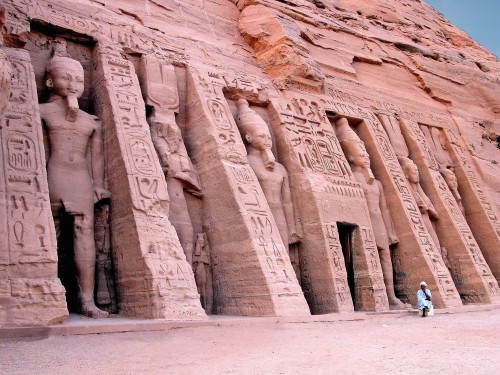
The Small Temple, Abu Simbel
Meritamen : Also known as Merytamun, the fourth daughter of Ramesses II and Nefertari. It is assumed that Meritamen received the title of God's Wife from Nefertari, but this is uncertain. It is only known she held the position of "Superior of the Harem of Amun-Ra" while Nefertari lived. Most likely, she became God's Wife when she was elevated by her father to Great Royal Wife following the death of Nefertari.
Twosret : Also known as Tawosret (1191-1190 BCE) was the step-mother of Siptah (1197-1191 BCE) who died at the age of 16. Twosret then ruled Egypt until her death when she was succeeded by Setnakhte (1190-1186 BCE) who founded the 20th Dynasty.
20TH DYNASTY
Isis-Ta-Hemdjert : The wife of Ramesses III (1186-1155 BCE) and mother of Ramesses IV (1155-1149 BCE). She conferred the title of God's Wife on her granddaughter Isis (daughter of Ramesses VI).
Isis : Also known as Iset and Aset, the daughter of Ramesses VI. She is the first known celibate God's Wife of Amun and initiated the policy which was adhered to from that time forward. God's Wives would henceforth be virgin daughters only, no longer wives or mothers.
Tyti : Possibly the wife of Ramesses X (1111-1107 BCE) but probably his maiden daughter. Very little is known of her.
Isis : Also known as Iset and Aset, the daughter of Ramesses VI. She is the first known celibate God's Wife of Amun and initiated the policy which was adhered to from that time forward. God's Wives would henceforth be virgin daughters only, no longer wives or mothers.
Tyti : Possibly the wife of Ramesses X (1111-1107 BCE) but probably his maiden daughter. Very little is known of her.
21ST DYNASTY TO THE INVASION
Maatkare : The daughter of the high priest Pinedjem I (1070-1032 BCE) and sister to the pharaoh Psusennes I (1047-1001 BCE). The cooperation of the high priest of Amun at Thebes and the king at Tanis during this time is well documented, though little is known of Maatkare's actual duties. She is best known from her tomb which contained her mummified pet monkey.
Henuttawy : The daughter of Pinedjem II (c.990-969 BCE) and his queen Isetemkheb.
Karomama : Also known as Karomama-Meryetmut and, to modern scholars, as Princess Karomama C, daughter of Osorkon II (872-837 BCE). Best known for her exquisite statue now in the Louvre, Paris.
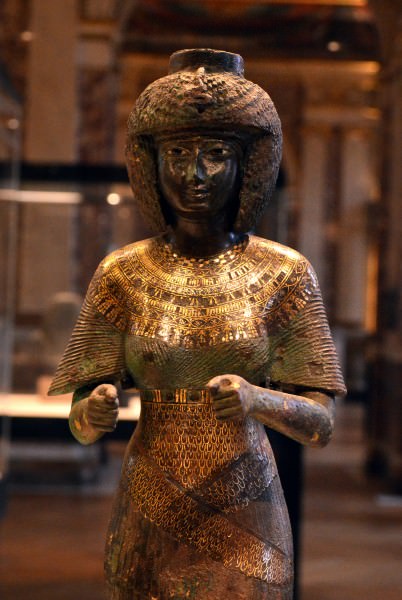
Queen Karomama I
Tashakheper : Another daughter of Osorkon II who does not seem to have held the title of God's Wife very long.
Shepenwepet I : The daughter of Osorkon III (c. 790 BCE) and Queen Karoatjet.
Amenirdis I : (c. 714-700 BCE) The daughter of Kashta (c. 750 BCE) and Queen Pebatjma, Sister of Piye (747-721 BCE) and his successor Shabaka (721-707 BCE). One of the most powerful of the God's Wives who effectively ruled Upper Egypt. She held the position of Divine Adoratrice before becoming God's Wife and High Priestess of Amun at Thebes.
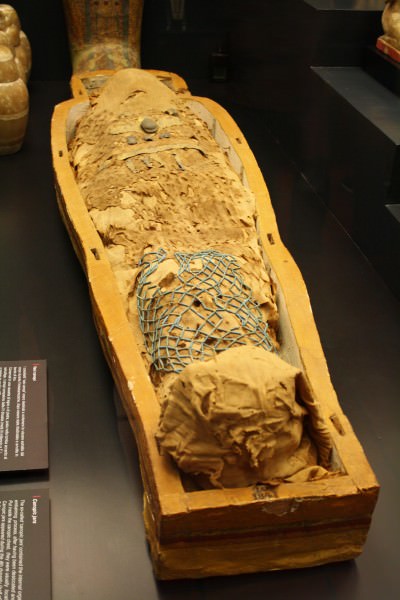
Mummy of Amenirdis
Shepenwepet II : The daughter of Piye and half-sister of King Taharqa (c. 690-671 BCE).
Amenirdis II : (c. 650-640 BCE) The daughter of Taharqa. She was selected as heir by Shepenwepet II but never actually occupied the position. Amenirdis II had adopted Nitokris I as her heir and the title passed directly to her when the Nubian rule in Egypt ended. Amenirdis II remained as the Divine Adoratrice to Nitokris I.
Nitokris I : (655-585 BCE) Also known as Neitiqert and Shepenwepet III, daughter of Psamtik I (c. 665-610 BCE) and his queen Mehytenweskhet. One of the wealthiest of God's Wives who ruled over seven districts in Upper Egypt and four in Lower Egypt and who commanded tribute of 420 pounds (190 kilograms) of bread, cereals, herbs, and milk daily from the priests of Amun as well as a monthly tribute of various foods and cattle (van de Mieroop, 275). She is among the most famous of God's Wives owing to inscriptions at Karnak, Abydos, and elsewhere and the Adoption Stele which recounts how Nitokris I became a God's Wife.
Shepenwepet IV : Most likely a daughter of King Necho II (610-595 BCE) and his queen Khedeb- neith -hirbinet.
Ankhenesneferibre : (c. 595-525 BCE) The daughter of Psamtik II (595-589 BCE) and his queen Takhuit. She ruled at Thebes until the Persian Invasion.
Nitokris II : The daughter of Amasis II (also known as Ahmose II, 570-526 BCE) who was chosen as Ankhenesneferibre's successor. She held the office of High Priestess of Amun at Thebes and Divine Adoratrice to Ankhenesneferibre. She is the last woman to be adopted as a successor to the title of God's Wife of Amun before the Persian Invasion.
THE PERSIAN INVASION
Amasis II was an exceptional military leader and administrator, but his son Psamtik III (526-525 BCE) was young and inexperienced when he came to the throne. According to Herodotus, the Persian king Cambyses II had sent to Amasis asking for one of his daughters as a wife but there was a long-standing policy in Egypt that daughters of royalty were not sent to foreign lands as wives.
Amasis II, therefore, could not comply but at the same time wished to avoid conflict, so he sent the daughter of a former ruler, Apries, instead. This princess of Egypt was deeply insulted by Amasis' decision and especially so because of the ancient Egyptian tradition which Amasis II had just ignored at her expense. When she arrived at Cambyses II's court, she revealed to him who she really was, and Cambyses II swore to avenge the insult of having been sent a 'fake wife.'
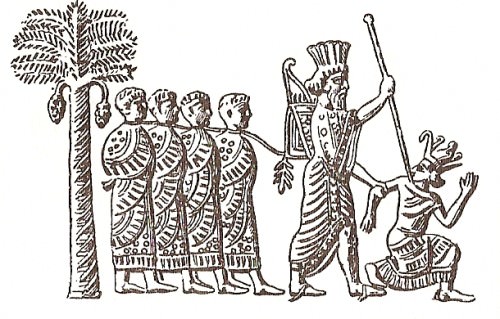
Cambyses II of Persia
Whether the details of this story are all true, the Persian army marched on Egypt in 525 BCE and met the forces of Psamtik III at the city of Pelusium. The city was heavily defended and Cambyses II understood he was probably facing heavy losses. He had long been an admirer of Egyptian culture, however, and knew of their deep devotion to cats and respect for animals.
He, therefore, ordered his men to round up cats and as many animals as they could find, and to also paint the image of Bastet, the Egyptian cat goddess, on their shields. The Persians drove the animals toward the city while raising their shields and demanding the Egyptian surrender. The defenders, not wishing to have the animals harmed and fearing lest they offend Bastet, complied; and Egypt fell to the Persians.
Although Egypt prospered under Persian rule, and the Persians respected the culture and the Egyptian religion, the title of God's Wife of Amun was abolished. The high priests of Amun now served the Persian kings and there was no longer an Egyptian royalty of any real power to confer the position on their daughters or to worry about the power of the priesthood in Egypt. The office of God's Wife of Amun was revived by the Nubian kings later, but after the massacre of the priests of Amun in 285 BCE by the king Ergamenes, it fell out of use, and the cult of Amun itself finally disappeared with the rise of Christianity.
Jezebel: Princess of Sidon, Queen of Israel › Who Was
Ancient Civilizations
Jezebel was the Phoenician Princess of Sidon (9th century BCE) whose story is told in the Hebrew Tanakh (the Christian Old Testament) in I and II Kings where she is portrayed unfavorably as a conniving harlot who corrupts Israel and flaunts the commandments of God. Recent scholarship, which has led to a better understanding of the civilization of Phoenicia, the role of women, and the struggle of the adherents of the Hebrew god Yahweh for dominance over the worship of the Canaanite deities Astarte and Baal, suggest a different, and more favorable, picture of Jezebel as a woman ahead of her time married into a culture whose religious class saw her as a formidable threat (phoenicia.org). The historian and biblical scholar Janet Howe Gaines notes this new interpretation in scholarship, writing :
For more than two thousand years, Jezebel has been saddled with a reputation as the bad girl of the Bible, the wickedest of women. This ancient queen has been denounced as a murderer, prostitute and enemy of God, and her name has been adopted for lingerie lines and World War II missiles alike. But just how depraved was Jezebel? In recent years, scholars have tried to reclaim the shadowy female figures whose tales are often only partially told in the Bible.

Jezebel
Although she has been associated with seduction, depravity, and harlotry for centuries, a more accurate understanding of Jezebel emerges as one considers the possibility she was simply a woman who refused to submit to the religious beliefs and practices of her husband and his culture. Her name has been claimed to mean, `Where is God?' or, alternately, `Where is The Prince' and even `Not Exalted'. All these claims come from sources antagonistic to Jezebel, however, and make little sense when one considers her father was King Ethbaal of Sidon, a Phonecian High Priest, who would hardly have given his daughter a name which literally meant she was not exalted, nor one which asked a question he already knew the answer to ("Where is God?" or "Where is the Prince?"). It is far more likely that her name means `Daughter of Baal' or, as one would say today, `Daughter of God'. The fact that her name has been interpreted in a negative light is symptomatic of the way she has been regarded since the narrative of I and II Kings was first written, but, as Gaines suggests:
There is more to this complex ruler than the standard interpretation would allow. To attain a more positive assessment of Jezebel's troubled reign and a deeper understanding of her role, we must evaluate the motives of the Biblical authors who condemn the queen. Furthermore, we must reread the narrative from the queen's vantage point. As we piece together the world in which Jezebel lived, a fuller picture of this fascinating woman begins to emerge. The story is not a pretty one, and some—perhaps most—readers will remain disturbed by Jezebel's actions. But her character might not be as dark as we are accustomed to thinking. Her evilness is not always as obvious, undisputed and unrivaled as the Biblical writer wants it to appear.
PHOENICIAN WOMEN ENJOYED ENORMOUS LIBERTY & WERE CONSIDERED THE EQUALS OF MALES.
Phoenician women enjoyed enormous liberty and were considered the equals of males. Both men and women presided over religious gatherings as priests and priestesses and, as daughter of a High Priest, Jezebel would have naturally been initiated into the priesthood. Her on-going conflict with the Prophet Elijah chronicled in I Kings has been interpreted by some as simply an impossible clash of cultural understanding as the Israelites were not accustomed to a strong female ruler and Jezebel was not used to second-class citizen status (phoenicia.org). Her actions may not always have been the most prudent and, sometimes, they were simply very wrong (as in the case of Naboth) but can be seen as the way in which a Phoenician princess would handle a situation without regard for the cultural norms of her husband's culture.
Jezebel was married, by contract, to King Ahab of the Northern Kingdom of Israel as a means to cement an alliance between that city and her home state of Sidon. As Gaines notes, there is no way of knowing whether she was pleased with this arrangement but, most likely, she was simply a political pawn in her father's game. Upon arrival in her new home, she almost immediately came into conflict with the religious class by importing her own priests and priestesses and setting up shrines and temples to the gods of her own understanding and beliefs. Her seemingly rebellious attitude toward the religion of her husband upsets the prophet Elijah who opposes her from the first. Their conflict escalates to the point where Elijah challenges Jezebel's priests of Baal to a duel on Mount Carmel. He will call on Yahweh to light a sacrificial bull on fire on an altar and Jezebel's priests will call on Baal; whichever deity is able to light the bull will win the challenge and be acknowledged as the true God.

Map of Phoenicia
In order to draw the attention of their god, the 850 priests of baal “performed a hopping dance about the altar”(I Kings 18:26).They also called on his name to hear their petitions and send fire to the altar. All day they danced and prayed and yet no answer came. Elijah, sitting nearby watching them, mocks the priests and asks where their god is. Perhaps, he suggests, Baal is too busy off somewhere eating or having sex or engaging in some other pleasure which prevents him from answering their prayers.
Once they have given up, and Elijah rises for his turn, the writer of I Kings makes it clear which deity is the true one by having Yahweh answer Elijah's prayer immediately: “fire from the Lord descended and consumed the burnt offering, the wood, the stones and the earth;…When they saw this, all the people flung themselves on their faces and cried out: 'The Lord alone is God, the Lord alone is God!'” (I Kings 18:38–39). Elijah has won his challenge and his god is proven to be the only true God, ruler of the heavens and earth. As this god's champion, it seems it is up to Elijah to now impose his god's will on the people of Israel. Gaines writes:
Ironically, at the conclusion of the Carmel episode, Elijah proves capable of the same murderous inclinations that have previously characterized Jezebel, though it is only she that the Deuteronomist criticizes. After winning the Carmel contest, Elijah immediately orders the assembly to capture all of Jezebel's prophets. Elijah emphatically declares: “Seize the prophets of Baal, let not a single one of them get away” (1 Kings 18:40). Elijah leads his 450 prisoners to the Wadi Kishon, where he slaughters them (1 Kings 18:40). Though they will never meet in person, Elijah and Jezebel are engaged in a hard-fought struggle for religious supremacy. Here Elijah reveals that he and Jezebel possess a similar religious fervor, though their loyalties differ greatly. They are also equally determined to eliminate one another's followers, even if it means murdering them. The difference is that the Deuteronomist decries Jezebel's killing of God's servants (at 1 Kings 18:4) but now sanctions Elijah's decision to massacre hundreds of Jezebel's prophets. Indeed, once Elijah kills Jezebel's prophets, God rewards him by sending a much-needed rain, ending a three-year drought in Israel. There is a definite double standard here. Murder seems to be accepted, even venerated, as long as it is done in the name of the right deity.
When Jezebel hears of what Elijah has done, she threatens his life and he flees the land. This is hardly the end of their power struggle, however. In I Kings the writer of the book reports how Jezebel orchestrates the murder of the landowner Naboth (slyly using Ahab's signet ring unlawfully to seal the messages sent) in order to give Ahab his vineyards. Ahab had demanded that Naboth sell him the vineyards since he, Ahab, was king and the vineyards close to his palace. When Naboth refused, Jezebel had him framed for treason and executed. This is all reported as though Jezebel was duplicitous in her dealings in using Ahab's ring to sign Naboth's death warrant. Recent archaelogical discoveries, however, reveal she had her own ring and, accordingly, authority as a monarch to take what actions she deemed necessary ( Science Daily). While there is no doubt that the murder of Naboth was unjust, to a queen used to having her own way, it may have seemed simple policy to remove a subject who refused the will of the monarchy.
Her story concludes as Elijah returns from exile and seizes upon Naboth's unlawful death as proof of Jezebel's wickedness.Ahab dies their second son, Joram, takes the throne and, at this point, Elijah's successor, Elisha, moves the Israelite General Jehu to revolt. Joram is murdered by Jehu and Jezebel is assassinated by two eunuchs (at Jehu's command) by being thrown from her window to the street below. The famous scene from II Kings 9:30-33 in which Jezebel applies make-up before her death, which has traditionally been interpreted as her attempt to seduce Jehu to spare her life, and has largely led to her reputation as a `whore', is now believed by some scholars to be the appropriate action of a Princess of Sidon and Queen of Israel, preparing for her end with dignity as a monarch and true priestess of her gods.
Whether Jezebel is to be considered along the lines of her traditional image, or in the light of new interpretations of the Bible and ancient history, is of course the choice of each individual. A careful examination of the text, however, keeping in mind the narrative focus and purpose of the writer of I and II Kings, may give a reader cause to re-think the popular image of the `wicked' queen Jezebel and her various schemes.
LICENSE:
Article based on information obtained from these sources:with permission from the Website Ancient History Encyclopedia
Content is available under License Creative Commons: Attribution-NonCommercial-ShareAlike 3.0 Unported. CC-BY-NC-SA License